Crux
Crux (/krʌks/) is a constellation centred on four stars in the southern sky in a bright portion of the Milky Way. It is among the most easily distinguished constellations as its hallmark (asterism) stars each have an apparent visual magnitude brighter than +2.8, even though it is the smallest of all 88 modern constellations. Its name is Latin for cross, and it is dominated by a cross-shaped or kite-like asterism that is commonly known as the Southern Cross.
| Constellation | |
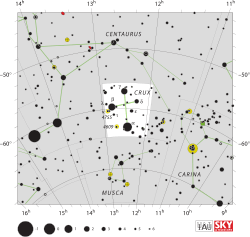 | |
| Abbreviation | Cru |
|---|---|
| Genitive | Crucis |
| Pronunciation | /krʌks/, genitive /ˈkruːsɪs/ |
| Symbolism | Southern Cross |
| Right ascension | 12.5h |
| Declination | −60° |
| Quadrant | SQ3 |
| Area | 68 sq. deg. (88th) |
| Main stars | 4 |
| Bayer/Flamsteed stars | 19 |
| Stars with planets | 2 |
| Stars brighter than 3.00m | 5 |
| Stars within 10.00 pc (32.62 ly) | 0 |
| Brightest star | Acrux (α Cru) (0.87m) |
| Messier objects | 0 |
| Meteor showers | Crucids |
| Bordering constellations | Centaurus Musca |
| Visible at latitudes between +20° and −90°. Best visible at 21:00 (9 p.m.) during the month of May. | |
Predominating the constellation is the first-magnitude blue-white star of α Crucis (Acrux), its brightest and most southerly member. There follow four less dominant stars which appear clockwise and in order of lessening magnitude: β Crucis (Mimosa), γ Crucis (Gacrux), δ Crucis (Imai) and ε Crucis (Ginan). Many of these brighter stars are members of the Scorpius–Centaurus Association, a large but loose group of hot blue-white stars that appear to share common origins and motion across the southern Milky Way.
Crux contains four Cepheid variables, each visible to the naked eye under optimum conditions. Crux also contains the bright and colourful open cluster known as the Jewel Box (NGC 4755) on its western border. To the southeast figures a large, relatively near dark nebula spanning 7° by 5° known as the Coalsack Nebula, portions of which are mapped in the neighbouring constellations of Centaurus and Musca.
History
The bright stars in Crux were known to the Ancient Greeks, where Ptolemy regarded them as part of the constellation Centaurus.[1][2] They were entirely visible as far north as Britain in the fourth millennium BC. However, the precession of the equinoxes gradually lowered the stars below the European horizon, and they were eventually forgotten by the inhabitants of northern latitudes.[3] By 400 CE, the stars in the constellation we now call Crux never rose above the horizon throughout most of Europe. Dante may have known about the constellation in the 14th century, as he describes an asterism of four bright stars in the southern sky in his Divine Comedy.[4] Others argue that Dante's description was allegorical, and that he almost certainly did not know about the constellation.[5]
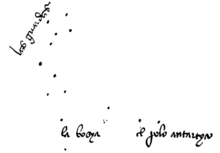
The 15th century Venetian navigator Alvise Cadamosto made note of what was probably the Southern Cross on exiting the Gambia River in 1455, calling it the carro dell'ostro ("southern chariot"). However, Cadamosto's accompanying diagram was inaccurate.[6][7] Historians generally credit João Faras[lower-alpha 1] for being the first European to depict it correctly. Faras sketched and described the constellation (calling it "Las Guardas") in a letter written on the beaches of Brazil on 1 May 1500 to the Portuguese monarch.[8][9]
Explorer Amerigo Vespucci seems to have observed not only the Southern Cross but also the neighboring Coalsack Nebula on his second voyage in 1501–1502.[10]
Another early modern description clearly describing Crux as a separate constellation is attributed to Andrea Corsali, an Italian navigator who from 1515–1517 sailed to China and the East Indies in an expedition sponsored by King Manuel I. In 1516, Corsali wrote a letter to the monarch describing his observations of the southern sky, which included a rather crude map of the stars around the south celestial pole including the Southern Cross and the two Magellanic Clouds seen in an external orientation, as on a globe.[11][12]
Emery Molyneux and Petrus Plancius have also been cited as the first uranographers (sky mappers) to distinguish Crux as a separate constellation; their representations date from 1592, the former depicting it on his celestial globe and the latter in one of the small celestial maps on his large wall map. Both authors, however, depended on unreliable sources and placed Crux in the wrong position. Crux was first shown in its correct position on the celestial globes of Petrus Plancius and Jodocus Hondius in 1598 and 1600. Its stars were first catalogued separately from Centaurus by Frederick de Houtman in 1603.[13] The constellation was later adopted by Jakob Bartsch in 1624 and Augustin Royer in 1679. Royer is sometimes wrongly cited as initially distinguishing Crux.[2]
Characteristics
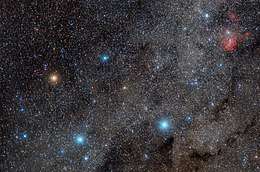
Crux is bordered by the constellations Centaurus (which surrounds it on three sides) on the east, north and west, and Musca to the south. Covering 68 square degrees and 0.165% of the night sky, it is the smallest of the 88 constellations.[14] The three-letter abbreviation for the constellation, as adopted by the International Astronomical Union in 1922, is "Cru".[15] The official constellation boundaries, as set by Eugène Delporte in 1930, are defined by a polygon of four segments. In the equatorial coordinate system, the right ascension coordinates of these borders lie between 11h 56.13m and 12h 57.45m, while the declination coordinates are between −55.68° and −64.70°.[16] Its totality figures at least part of the year south of the 25th parallel north.[17][lower-alpha 2]
In tropical regions Crux can be seen in the sky from April to June. Crux is exactly opposite to Cassiopeia on the celestial sphere, and therefore it cannot appear in the sky with the latter at the same time. In this era, south of Cape Town, Adelaide and Buenos Aires (the 34th parallel south), Crux is circumpolar and thus always appears in the sky.
Crux is sometimes confused with the nearby False Cross by stargazers. The False Cross is larger and dimmer, does not have a fifth star, and lacks the two prominent nearby "Pointer Stars". Between the two is the even larger and dimmer Diamond Cross.
Visibility
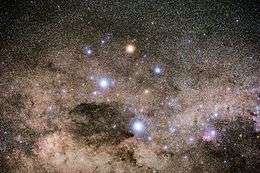
Crux is easily visible from the southern hemisphere at practically any time of year. It is also visible near the horizon from tropical latitudes of the northern hemisphere for a few hours every night during the northern winter and spring. For instance, it is visible from Cancun or any other place at latitude 25° N or less at around 10 pm at the end of April.[18][19] There are 5 main stars. Due to precession, Crux will move closer to the South Pole in the next millennia, up to 67 degrees south declination for the middle of the constellation. However, by the year 14,000 Crux will be visible for most parts of Europe and continental United States which will extend to North Europe by the year 18,000 as it will be less than 30 degrees south declination.
Use in navigation

In the Southern Hemisphere, the Southern Cross is frequently used for navigation in much the same way that Polaris is used in the Northern Hemisphere. Projecting a line from γ to α Crucis (the foot of the crucifix) approximately 4 1⁄2 times beyond gives a point close to the Southern Celestial Pole[3] which is also, coincidentally, where intersects a perpendicular line taken southwards from the east-west axis of Alpha Centauri to Beta Centauri, which are stars at an alike declination to Crux and of a similar width as the cross, but higher magnitude.[20] Argentine gauchos are documented as using Crux for night orientation in the Pampas and Patagonia.
Alpha and Beta Centauri are of similar declinations (thus distance from the pole) are often referred as the "Southern Pointers" or just "The Pointers", allowing people to easily identify the Southern Cross, the constellation of Crux. Very few bright stars of importance lie between Crux and the pole itself, although the constellation Musca is fairly easily recognised immediately beneath Crux.[20]
Circumscribed limits around apparent bright stars
Down to apparent magnitude +2.5 are 92 stars that shine the brightest as viewed from the Earth. Three of these stars are in Crux making it the most densely populated as to those stars (this being 3.26% of these 92 stars, and in turn being 19.2 times more than the expected 0.17% that would result on a homogenous distribution of all bright stars and a randomised drawing of all 88 constellations, given its area, 0.17% of the sky).
Features
Stars
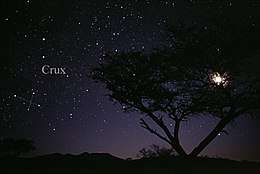
Within the constellation's borders, there are 49 stars brighter than or equal to apparent magnitude 6.5.[lower-alpha 3][17] The four main stars that form the asterism are Alpha, Beta, Gamma, and Delta Crucis.
- α Crucis or Acrux is a triple star 321 light-years from Earth. A rich blue in colour, with a visual magnitude 0.8 to the unaided eye, it has two close components of a similar magnitude, 1.3 and 1.8 respectively, plus another much wider component of the 5th magnitude. The two close components are resolved in a small amateur telescope and the wide component is readily visible in a pair of binoculars.
- β Crucis or Mimosa is a blue-hued giant star of magnitude 1.3, and lies 353 light-years from Earth. It is a Beta Cephei-type variable star with a variation of less than 0.1 magnitudes.[3]
- γ Crucis or Gacrux is an optical double star. The primary is a red-hued giant star of magnitude 1.6, 88 light-years from Earth, and is one of the closest red giants to Earth. Its secondary component is magnitude 6.5, 264 light-years from Earth.
- δ Crucis (Imai) is a magnitude 2.8 blue-white hued star about 345 light-years from Earth.[3] Like Mimosa it is a Beta Cepheid variable.[14]
There is also a fifth star, that is often included with the Southern Cross.
- ε Crucis (Ginan) is an orange-hued giant star of magnitude 3.6, 228 light-years from Earth.
There are several other naked-eye stars within the borders of Crux, especially:
- Iota Crucis is a visual double star 125 light-years from Earth. The primary is an orange-hued giant of magnitude 4.6 and the secondary at magnitude 9.5.
- Mu Crucis or Mu1,2 Crucis is a wide double star where the components are about 370 light-years from Earth. Equally blue-white in colour, the components are magnitude 4.0 and 5.1 respectively, and are easily divisible in small amateur telescopes or large binoculars.[3]
Scorpius–Centaurus Association members
Unusually, a total of 15 of the 23 brightest stars in Crux are spectrally blue-white B-type stars.[14] Among the five main bright stars, Delta, and probably Alpha and Beta, are likely co-moving B-type members of the Scorpius–Centaurus Association, the nearest OB association to the Sun.[22][23] They are among the highest-mass stellar members of the Lower Centaurus-Crux subgroup of the association, with ages of roughly 10 to 20 million years.[24][25] Other members include the blue-white stars Zeta, Lambda and both the components of the visual double star, Mu.[26]
Variable stars
Crux contains many variable stars. It boasts four Cepheid variables that may all reach naked eye visibility.
- BG Crucis ranges from magnitude 5.34 to 5.58 over 3.3428 days,[27]
- T Crucis ranges from 6.32 to 6.83 over 6.73331 days,[28]
- S Crucis ranges from 6.22 to 6.92 over 4.68997 days,[29]
- R Crucis ranges from 6.4 to 7.23 over 5.82575 days.[30]
Other well studied variable stars includes:
- Lambda Crucis and Theta2 Crucis, that are both Beta Cepheid type variable stars.[14]
- BH Crucis, also known as Welch's Red Variable, is a Mira variable that ranges from magnitude 6.6 to 9.8 over 530 days.[31] Discovered in October 1969, it has become redder and brighter (mean magnitude changing from 8.047 to 7.762) and its period lengthened by 25% in the first thirty years since its discovery.[32]
Host star exoplanets in Crux
The star HD 106906 has been found to have a planet—HD 106906 b—that has one of the widest orbits of any currently known planetary-mass companions..[33]
Visible objects beyond the Local Arm
Crux is backlit by the multitude of stars of the Scutum-Crux Arm (more commonly called Scutum-Centaurus) Arm of the Milky Way. As to the local radial quarter of the galaxy, this is the main inner arm.
Part-obscuring this is:
- The Coalsack Nebula lies partially within Crux and partly in the neighboring constellations of Musca and Centaurus.[3] It is the most prominent dark nebula in the skies, and is easily visible to the naked eye as a prominent dark patch in the southern Milky Way. It It can be found 6.5° southeast from the centre of Crux or 3° east from α Crucis. Its large area covers about 7° by 5°, and is 180 parsecs (590 ly) away from Earth.[34]
A key feature of the Arm mentioned relatively near to our position is:
- The Jewel Box, κ/Kappa Crucis Cluster or NGC 4755, is a small but bright open cluster that appears as a fuzzy star to the naked eye and is placed very close to the westernmost boundary of Crux: about 1° southwest of Beta Crucis The combined or total magnitude is 4.2 and it lies at a distance of 1.95 kiloparsecs (6,400 ly) from Earth.[3] The cluster was given its name by John Herschel,[3] based on the range of colours visible throughout the star cluster in his telescope. About seven million years old,[35] it is one of the youngest open clusters in the Milky Way, and it appears to have the shape of a letter 'A'. The Jewel Box Cluster is classified as Shapley class 'g' and Trumpler class 'I 3 r -' cluster; it is a very rich, centrally-concentrated cluster detached from the surrounding star field. It has more than 100 stars that range significantly in brightness.[36] The brightest cluster stars are mostly blue supergiants, though the cluster contains at least one red supergiant. Kappa Crucis is a true member of the cluster that bears its name, and is one of the brighter stars at magnitude 5.9.[3]
Cultural significance
The most prominent feature of Crux is the distinctive asterism known as the Southern Cross. It has great significance in the cultures of the southern hemisphere, particularly of Australia and New Zealand.[37]
Flags and symbols
Several southern countries and organisations have traditionally used Crux as a national or distinctive symbol. The four or five brightest stars of Crux appear, heraldically standardised in various ways, on the flags of Australia, Brazil, New Zealand, Papua New Guinea and Samoa. They also appear on the flags of the Australian state of Victoria, the Australian Capital Territory, the Northern Territory, as well as the flag of Magallanes Region of Chile, the flag of Londrina (Brazil) and several Argentine provincial flags and emblems (for example, Tierra del Fuego and Santa Cruz). The flag of the Mercosur trading zone displays the four brightest stars. Crux also appears on the Brazilian coat of arms and, as of July 2015, on the cover of Brazilian passports.
Five stars appear in the logo of the Brazilian football team Cruzeiro Esporte Clube and in the Brazilian coat of arms, and the cross has featured as name of the Brazilian currency (the cruzeiro from 1942 to 1986 and again from 1990 to 1994). All coins of the current (1998) series of the Brazilian real display the constellation.
Songs and literature reference the Southern Cross, including the Argentine epic poem Martín Fierro. The Argentinian singer Charly García says that he is "from the Southern Cross" in the song "No voy en tren".
The Cross gets a mention in the lyrics of the Brazilian National Anthem (1909): "A imagem do Cruzeiro resplandece" ("the image of the Cross shines").
The Southern Cross is mentioned in the Australian National Anthem, "Beneath our radiant Southern Cross we'll toil with hearts and hands"
The Southern Cross is also mentioned in the Samoan National Anthem. "Vaai 'i na fetu o lo'u a agiagia ai: Le faailoga lea o Iesu, na maliu ai mo Samoa." ("Look at those stars that are waving on it: This is the symbol of Jesus, who died on it for Samoa.")
"Southern Cross" is a single released by Crosby, Stills and Nash in 1981. It reached #18 on Billboard Hot 100 in late 1982.
The Order of the Southern Cross is a Brazilian order of chivalry awarded to "those who have rendered significant service to the Brazilian nation".
In "O Sweet Saint Martin's Land", the lyrics mention the Southern Cross: Thy Southern Cross the night.
A stylized version of Crux appears on the Australian Eureka Flag. The constellation was also used on the dark blue, shield-like patch worn by personnel of the U.S. Army's Americal Division, which was organized in the Southern Hemisphere, on the island of New Caledonia, and also on the blue diamond of the U.S. 1st Marine Division, which fought on the Southern Hemisphere islands of Guadalcanal and New Britain.
The Petersflagge flag of the German East Africa Company of 1885–1920, which included a constellation of five white five-pointed Crux "stars" on a red ground, later served as the model for symbolism associated with generic German colonial-oriented organisations: the Reichskolonialbund of 1936–1943 and the Friends of the former German Protectorates (1956/1983 to the present).
Southern Cross station is a major rail terminal in Melbourne, Australia.[38]
The Personal Ordinariate of Our Lady of the Southern Cross is a personal ordinariate of the Roman Catholic Church primarily within the territory of the Australian Catholic Bishops Conference for groups of Anglicans who desire full communion with the Catholic Church in Australia and Asia.
The Knights of the Southern Cross (KSC) is a Catholic fraternal order throughout Australia.
In non-Western astronomy
In Australian Aboriginal astronomy, Crux and the Coalsack mark the head of the 'Emu in the Sky' (which is seen in the dark spaces rather than in the patterns of stars) in several Aboriginal cultures,[39] while Crux itself is said to be a possum sitting in a tree (Boorong people of the Wimmera region of northwestern Victoria), a representation of the sky deity Mirrabooka (Quandamooka people of Stradbroke Island), a stingray (Yolngu people of Arnhem Land), or an eagle (Kaurna people of the Adelaide Plains).[40] Two Pacific constellations also included Gamma Centauri. Torres Strait Islanders in modern-day Australia saw Gamma Centauri as the handle and the four stars as the trident of Tagai's Fishing Spear. The Aranda people of central Australia saw the four Cross stars as the talon of an eagle and Gamma Centauri as its leg.[41]
Various peoples in the East Indies and Brazil viewed the four main stars as the body of a ray.[41] In both Indonesia and Malaysia, it is known as Bintang Pari and Buruj Pari, respectively ("ray stars"). This aquatic theme is also shared by an archaic name of the constellation in Vietnam, where it was once known as sao Cá Liệt (the ponyfish star).[42]
The Javanese people of Indonesia called this constellation Gubug pèncèng ("raking hut") or lumbung ("the granary"), because the shape of the constellation was like that of a raking hut.[43]
The Southern Cross (α, β, γ and δ Crucis) together with μ Crucis is one of the asterisms used by Bugis sailors for navigation, called bintoéng bola képpang, meaning "incomplete house star"[44]
The Māori name for the Southern Cross is Māhutonga and it is thought of as the anchor (Te Punga) of Tama-rereti's waka (the Milky Way), while the Pointers are its rope.[45] In Tonga it is known as Toloa ("duck"); it is depicted as a duck flying south, with one of his wings (δ Crucis) wounded because Ongo tangata ("two men", α and β Centauri) threw a stone at it. The Coalsack is known as Humu (the "triggerfish"), because of its shape.[46] In Samoa the constellation is called Sumu ("triggerfish") because of its rhomboid shape, while α and β Centauri are called Luatagata (Two Men), just as they are in Tonga. The peoples of the Solomon Islands saw several figures in the Southern Cross. These included a knee protector and a net used to catch Palolo worms. Neighboring peoples in the Marshall Islands saw these stars as a fish.[41]
In Mapudungun, the language of Patagonian Mapuches, the name of the Southern Cross is Melipal, which means "four stars". In Quechua, the language of the Inca civilization, Crux is known as "Chakana", which means literally "stair" (chaka, bridge, link; hanan, high, above), but carries a deep symbolism within Quechua mysticism.[47] Alpha and Beta Crucis make up one foot of the Great Rhea, a constellation encompassing Centaurus and Circinus along with the two bright stars. The Great Rhea was a constellation of the Bororo of Brazil. The Mocoví people of Argentina also saw a rhea including the stars of Crux. Their rhea is attacked by two dogs, represented by bright stars in Centaurus and Circinus. The dogs' heads are marked by Alpha and Beta Centauri. The rhea's body is marked by the four main stars of Crux, while its head is Gamma Centauri and its feet are the bright stars of Musca.[48] The Bakairi people of Brazil had a sprawling constellation representing a bird snare. It included the bright stars of Crux, the southern part of Centaurus, Circinus, at least one star in Lupus, the bright stars of Musca, Beta and the optical double star Delta1,2 Chamaeleontis: and some of the stars of Volans, and Mensa.[49] The Kalapalo people of Mato Grosso state in Brazil saw the stars of Crux as Aganagi angry bees having emerged from the Coalsack, which they saw as the beehive.[50]
Among Tuaregs, the four most visible stars of Crux are considered iggaren, i.e. four Maerua crassifolia trees. The Tswana people of Botswana saw the constellation as Dithutlwa, two giraffes – Alpha and Beta Crucis forming a male, and Gamma and Delta forming the female.[51]
See also
- Trishanku
- Crux (Chinese astronomy)
Notes
- João Faras was an astronomer and physician of King Manuel I of Portugal who accompanied Pedro Álvares Cabral in the discovery of Brazil in 1500
- While parts of the constellation technically rise above the horizon to observers between 25°N and 34°N, stars within a few degrees of the horizon are to all intents and purposes unobservable.[17]
- Objects of magnitude 6.5 are among the faintest visible to the unaided eye in suburban-rural transition night skies.[21]
References
- Citations
- Pasachoff (2006). Stars and Planets. p. 144. ISBN 9780395910993.
- Staal 1988, p. 247.
- Ridpath & Tirion 2017, pp. 134–135.
- Walker, J. J. (22 December 1881). "Dante and the Southern Cross". Nature. 25 (636): 173. doi:10.1038/025217b0.
- Dante Alighieri (2003-05-27). The Divine Comedy. ISBN 9781101117996.
- Cadamosto, A. (c. 1465). Navigatione (1550 Ramusio ed.). p. 116r.
We likewise observed ... due south by compass, a constellation of six large bright stars, in the figure of a cross in this form ... we conjectured this to be the southern chariot, but could not expect to observe the principal star, as we had not yet lost sight of the north pole.
Cadamosto, A. (c. 1465). Navigatione (1811 Kerr ed.). p. 244.. However, no manuscript of Cadamosto's notebook has survived, only the printed version, and the errors in the diagram may be due to the printer's decision. - Dekker, Elly (1990). Annals of Science. 47. pp. 530–533.
- Revista do Instituto Histórico e Geográfico Brasileiro. V. Rio de Janeiro. 1843.
- Dekker, Elly (1990). Annals of Science. 47. pp. 533–535.
- Dekker, Elly (1990). Annals of Science. 47. pp. 535–543.
- Dekker, Elly (1990). Annals of Science. 47. pp. 545–548.
- "Letter to Giuliano de Medici". State Library of New South Wales. c. 1516. Retrieved 1 February 2018.
- "Ian Ridpath's Star Tales – Crux". Retrieved 5 August 2013.
- Bagnall, Philip M. (2012). The Star Atlas Companion: What You Need to Know about the Constellations. New York, New York: Springer. pp. 183–87. ISBN 978-1-4614-0830-7.
- Russell, Henry Norris (1922). "The New International Symbols for the Constellations". Popular Astronomy. 30: 469. Bibcode:1922PA.....30..469R.
- "Crux, Constellation Boundary". The Constellations. International Astronomical Union. Retrieved 23 June 2014.
- Ian Ridpath. "Constellations: Andromeda–Indus". Star Tales. self-published. Retrieved 23 June 2014.
- Pasachoff, Jay M (2000). Field Guide to the Stars and Planets. Houghton Miflin. p. 67. ISBN 978-0-395-93431-9.
- "Ian Ridpath.com: Constellations". Retrieved 2015-09-29.
- Grainger, DH. Don't die in the Bundu (8th ed.). Cape Town. pp. 84–86. ISBN 0-86978-056-5.
- Bortle, John E. (February 2001). "The Bortle Dark-Sky Scale". Sky & Telescope. Sky Publishing Corporation. Retrieved 29 November 2014.
- Preibisch, T.; Mamajek, E. (2008). "The Nearest OB Association: Scorpius-Centaurus (Sco OB2)". Handbook of Star-Forming Regions. 2: 0. arXiv:0809.0407. Bibcode:2008hsf2.book..235P.
- Rizzuto, Aaron; Ireland, Michael; Robertson, J. G. (October 2011), "Multidimensional Bayesian membership analysis of the Sco OB2 moving group", Monthly Notices of the Royal Astronomical Society, 416 (4): 3108–3117, arXiv:1106.2857, Bibcode:2011MNRAS.416.3108R, doi:10.1111/j.1365-2966.2011.19256.x.
- de Geus, E. J.; de Zeeuw, P. T. & Lub, J. (1989). "Physical Parameters of Stars in the Scorpio-Centaurus OB Association". Astronomy & Astrophysics. 216 (3): 44–61. Bibcode:1989A&A...216...44D.
- Mamajek, E.E.; Meyer, M.R.; Liebert, J. (2002). "Post-T Tauri Stars in the Nearest OB Association". Astronomical Journal. 124 (3): 1670–1694. arXiv:astro-ph/0205417. Bibcode:2002AJ....124.1670M. doi:10.1086/341952.
- de Zeeuw, P.T.; Hoogerwerf, R.; de Bruijne, J.H.J.; Brown, A.G.A.; Blaauw, A. (1999). "A Hipparcos Census of Nearby OB Associations". Astronomical Journal. 117 (1): 354–99. arXiv:astro-ph/9809227. Bibcode:1999AJ....117..354D. doi:10.1086/300682.
- Watson, Christopher (4 January 2010). "BG Crucis". AAVSO Website. American Association of Variable Star Observers. Retrieved 12 March 2014.
- Watson, Christopher (4 January 2010). "T Crucis". AAVSO Website. American Association of Variable Star Observers. Retrieved 12 March 2014.
- Watson, Christopher (4 January 2010). "S Crucis". AAVSO Website. American Association of Variable Star Observers. Retrieved 12 March 2014.
- Watson, Christopher (4 January 2010). "R Crucis". AAVSO Website. American Association of Variable Star Observers. Retrieved 12 March 2014.
- Otero, Sebastian (6 January 2011). "BH Crucis". AAVSO Website. American Association of Variable Star Observers. Retrieved 23 June 2014.
- Walker, W.S.G. (2009). "BH Crucis : Period, Magnitude, and Color Changes". J. Am. Assoc. Variable Star Obs. 37 (2): 87–95. Bibcode:2009JAVSO..37...87W.
- Bailey, Vanessa; et al. (January 2014). "HD 106906 b: A planetary-mass companion outside a massive debris disk". The Astrophysical Journal Letters. 780 (1): L4. arXiv:1312.1265. Bibcode:2014ApJ...780L...4B. doi:10.1088/2041-8205/780/1/L4.
- Franco, G.P.A. (2000). "Interstellar Na I D lines towards the Southern Coalsack". Monthly Notices of the Royal Astronomical Society. 315 (3): 611–621. Bibcode:2000MNRAS.315..611F. doi:10.1046/j.1365-8711.2000.03434.x.
- "WEBDA Open cluster". Results for NGC 4755. Retrieved 30 April 2019.
- Levy 2005, p. 87.
- "Story: Southern Cross".
- "Southern Cross Railway Station, Victoria – Railway Technology". Railway Technology. Retrieved 2018-04-19.
- Norris, R. (2007): The Emu in the Sky Australian Aboriginal Astronomy website. Retrieved 2 May 2013.
- Musgrave, I.: May sky guide: The Eta Aquarid meteor shower, constellations and planets ABC News, 2 May 2016. Retrieved 2 May 2016.
- Staal 1988, p. 249.
- Huỳnh, Tịnh Của (1895). Đại Nam quấc âm tự vị [Dictionnaire annamite] (in Vietnamese).
Nam tào: "tên sao chòm ở phía nam, cũng là sao cá liệt" ... – " the name of a constellation in the south, also known as the ponyfish star."
- Daldjoeni, N. (1984). "Pranatamangsa, the javanese agricultural calendar – Its bioclimatological and sociocultural function in developing rural life". The Environmentalist. 4: 15–18. doi:10.1007/BF01907286.
- Kelley, David H.; Milone, Eugene F.; Aveni, A.F. (2011). Exploring Ancient Skies: A Survey of Ancient and Cultural Astronomy. New York, New York: Springer. p. 344. ISBN 978-1-4419-7623-9.
- "Māori Dictionary; Waka o Tama-rereti, Te". Retrieved 4 February 2013.
- Velt 1990.
- "Chakana: Inca Cross". 23 June 2007. Archived from the original on 4 January 2012. Retrieved 9 July 2012.
- Staal 1988, p. 251.
- Staal 1988, p. 250.
- Basso, Ellen B. (1987). In Favor of Deceit: A Study of Tricksters in an Amazonian Society. Tucson, Arizona: University of Arizona Press. p. 360. ISBN 0816510229.
- Clegg, Andrew (1986). "Some Aspects of Tswana Cosmology". Botswana Notes and Records. 18: 33–37. JSTOR 40979758.
- Sources
- Levy, David H. (2005), Deep Sky Objects, Prometheus Books, ISBN 1-59102-361-0
- Pasachoff, Jay M. (2006), A Field Guide to the Stars and Planets, Houghton Mifflin
- Ridpath, Ian; Tirion, Wil (2017), Stars and Planets Guide, Princeton University Press, ISBN 9780691177885
- Staal, Julius D. W. (1988), The New Patterns in the Sky: Myths and Legends of the Stars, McDonald and Woodward Publishing Company, ISBN 0939923041
- Velt, Kik (1990), Stars Over Tonga, 'Atenisi University
External links
| Wikimedia Commons has media related to: |
- Finding the South Pole in the sky
- The clickable Crux
- Southern Cross in Te Ara – the Encyclopedia of New Zealand
- Andrea Corsali – Letter to Giuliano de Medici, 1516 showing the Southern Cross at the State Library of NSW
- Letter of Andrea Corsali 1516–1989: with additional material ("the first description and illustration of the Southern Cross, with speculations about Australia ...") digitised by the National Library of Australia.